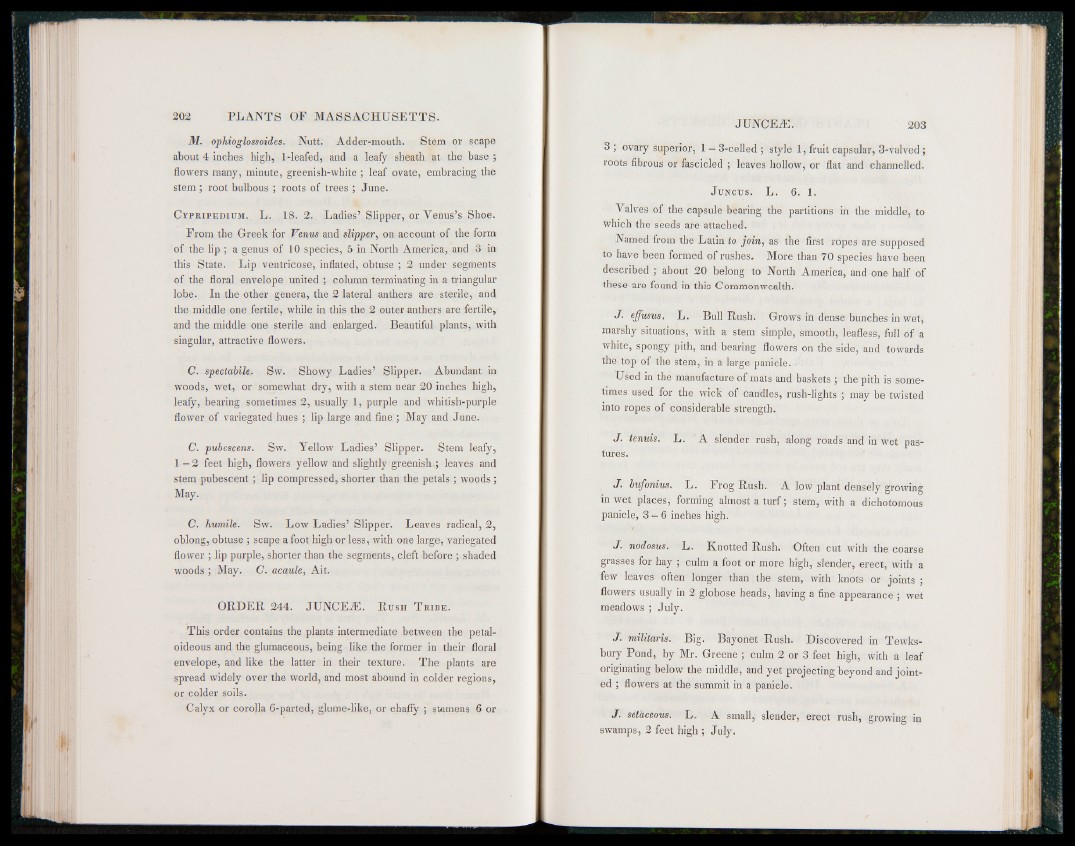
M. ophioglossoides. Nutt. Adder-mouth. Stem or scape
about 4 inches high, 1-leafed, and a leafy sheath at the base ;
flowers many, minute, greenish-white ; leaf ovate, embracing the
stem ; root bulbous ; roots of trees ; June.
C v pr ip ed ium. L. 18. 2. Ladies’ Slipper, or Venus’s Shoe.
From the Greek for Venus and slipper, on account of the form
of the lip ; a genus of 10 species, 5 in North America, and 3 in
this State. Lip ventricose, inflated, obtuse ; 2 under segments
of the floral envelope united ; column terminating in a triangular
lobe. In the other genera, the 2 lateral anthers are sterile, and
the middle one fertile, while in this the 2 outer anthers are fertile,
and the middle one sterile and enlarged. Beautiful plants, with
singular, attractive flowers.
G. spectabile.. Sw. Showy Ladies’ Slipper. Abundant in
woods, wet, or somewhat dry, with a stem near 20 inches high,
leafy, bearing sometimes 2, usually 1, purple and whitish-purple
flower of variegated hues ; lip large and fine ; May and June.
C. pubescens. Sw. Yellow Ladies’ Slipper. Stem leafy,
1—2 feet high, flowers yellow and slightly greenish,; leaves and
stem pubescent; lip compressed, shorter than the petals ; woods;
May.
C. humile. Sw. Low Ladies’ Slipper. Leaves radical, 2,
oblong, obtuse ; scape a foot high or less, with one large, variegated
flower ; lip purple, shorter than the segments, cleft before ; shaded
woods ; May. C. acaule, Ait.
O R D E R 244. JUNCEiE. R ush T r ib e .
This order contains the plants intermediate between the petal-
oideous and the glumaceous, being like the former in their floral
envelope, and like the latter in their texture. The plants are
spread widely over the world, and most abound in colder regions,
or colder soils.
Calyx or corolla 6-parted, glume-like, or chaffy ; stamens 6 or
JUNCEjE . 203
3 ; ovary superior, 1 — 3-celled ; style 1, fruit capsular, 3-valved ;
roots fibrous or fascicled ; leaves hollow, or flat and channelled.
J uncus. L. 6. 1.
Valves of the capsule bearing the partitions in the middle, to
which the seeds are attached.
Named from the Latin to join, as the first ropes are supposed
to have been formed of rushes. More than 70 species have been
described ; about 20 belong to North America, and one half of
these are found in this Commonwealth.
J. effusus. L. Bull Rush. Grows in dense bunches in wet,
marshy situations, with a stem simple, smooth, leafless, full of a
white, spongy pith, and bearing flowers on the side, and towards
the top of the stem, in a large panicle.
Ui^ed in the manufacture of mats and baskets ; the pith is sometimes
used for the wick of candles, rush-lights ; may be twisted
into ropes of considerable strength.
J- tenuis. L. A slender rush, along roads and in wet pastures.
J. bufonius. L. Frog Rush. A low plant densely growing
in wet places,- forming almost a tu rf; stem, with a dichotomous
panicle, 3 - 6 inches high.
J. nodosus. L. Knotted Rush. Often cut with the coarse
grasses for hay ; culm a foot or more high, slender, erect, with a
few leaves often longer than the stem, with knots or joints ;
flowers usually in 2 globose heads, having a fine appearance ; wet
meadows ; July.
J. militaris. Big. Bayonet Rush. Discovered in Tewksbury
Pond, by Mr. Greene ; culm 2 or 3 feet high, with a leaf
originating below the middle, and yet projecting beyond and jointed
; flowers at the summit in a panicle.
J. sethceous. L. A small,' slender, erect rush, growing in
swamps, 2 feet high ; July.